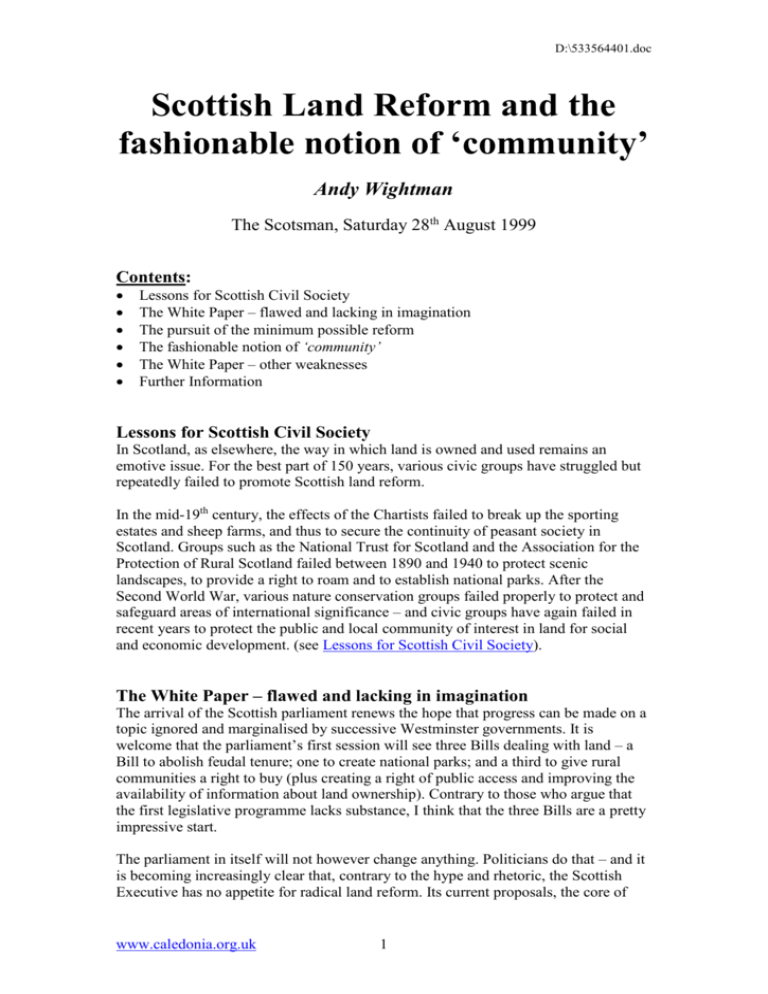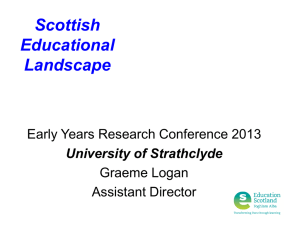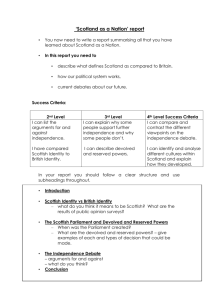34Kb doc
advertisement

D:\533564401.doc Scottish Land Reform and the fashionable notion of ‘community’ Andy Wightman The Scotsman, Saturday 28th August 1999 Contents: Lessons for Scottish Civil Society The White Paper – flawed and lacking in imagination The pursuit of the minimum possible reform The fashionable notion of ‘community’ The White Paper – other weaknesses Further Information Lessons for Scottish Civil Society In Scotland, as elsewhere, the way in which land is owned and used remains an emotive issue. For the best part of 150 years, various civic groups have struggled but repeatedly failed to promote Scottish land reform. In the mid-19th century, the effects of the Chartists failed to break up the sporting estates and sheep farms, and thus to secure the continuity of peasant society in Scotland. Groups such as the National Trust for Scotland and the Association for the Protection of Rural Scotland failed between 1890 and 1940 to protect scenic landscapes, to provide a right to roam and to establish national parks. After the Second World War, various nature conservation groups failed properly to protect and safeguard areas of international significance – and civic groups have again failed in recent years to protect the public and local community of interest in land for social and economic development. (see Lessons for Scottish Civil Society). The White Paper – flawed and lacking in imagination The arrival of the Scottish parliament renews the hope that progress can be made on a topic ignored and marginalised by successive Westminster governments. It is welcome that the parliament’s first session will see three Bills dealing with land – a Bill to abolish feudal tenure; one to create national parks; and a third to give rural communities a right to buy (plus creating a right of public access and improving the availability of information about land ownership). Contrary to those who argue that the first legislative programme lacks substance, I think that the three Bills are a pretty impressive start. The parliament in itself will not however change anything. Politicians do that – and it is becoming increasingly clear that, contrary to the hype and rhetoric, the Scottish Executive has no appetite for radical land reform. Its current proposals, the core of www.caledonia.org.uk 1 D:\533564401.doc which were spelled out in a White Paper: Land Reform - Proposals for Legislation publish in July, are based on a flawed, shallow, partial analysis of the land problem and reveal a timidity and poverty of imagination when it comes to tackling landed power. The pursuit of the minimum possible reform As Dr Ewen Cameron, a historian at Edinburgh University, recently observed, the proposals “represent the pursuit of what is least disruptive, the minimum possible reform to retain support and to argue that promises have been fulfilled while alienating the fewest.” And the proposals are so modest and timid because they dodge the overwhelming feature of Scottish land ownership – its remarkably concentrated pattern. In 1872 around 100 landowners owned half of the private land in Scotland; in 1970 this figure had risen to 313 landowners and by 1999 to 343. At this rate, by the end of the 21st century there will be 494 owners controlling 50 percent of private land in Scotland. Hardly a revolution. It does not take an arithmetical genius to work out that securing even a modest reduction in land owning monopolies will fail hopelessly unless clear policies are adopted to reduce the scale of landholdings. And although the Government has stated that it wishes to see “less concentration of ownership,” the agenda it has developed will do little it anything to achieve this. The much hyped abolition of feudalism will have no impact, while proposals to give communities the right to buy land when it comes on the market will fail to achieve the Government’s objectives of empowering communities or effecting a rapid change in the pattern of land ownership. Why? Because most privately owned land in Scotland has not been exposed to sale either privately or openly for more than 100 years. At least 25 percent of estates over 1,000 acres have been held by the same families for more than 400 years. In the Highlands, more than 50 percent of private land has not been exposed since 1945 while 25 percent has not been exposed at any time in the 20th century. The community right to buy might better be described in such circumstances as the right to buy for the great-grandchildren of the community – and no community is likely to be empowered through speculation that at some future point it might be able to take over control of the land. The White Paper – other weaknesses The White Paper has other weaknesses. One is its focus on those who live and or work on the land. Any community body wishing to exercise the right to buy powers must comprise a majority of tenants and employees. But such individuals are likely to number only a very few in any community, this approach would actually rule out the kinds of initiatives taken in recent years to secure access to land. Not only would many previous initiatives such as Knoydart fail to meet the proposed criteria for eligibility, but Abriachan Forest Trust, whose project above Loch Ness provided the setting for the launch of the White Paper, would never have got off the ground. The White Paper goes on to suggest that members of the community body “must constitute a voting majority” where they set up a partnership with organisations such as conservation bodies or local authorities. This requirement will frustrate the types of www.caledonia.org.uk 2 D:\533564401.doc partnership developed in recent years – and would have ruled out major community land ownership initiatives such as Eigg and Knoydart. The fashionable notion of ‘community’ Investing so much faith in the fashionable notion of ‘community’ is the key mistake. Why should a community be expected to become landowners any more than they should be expected to run hospitals or schools? At the root of the problem in many parts of rural Scotland is that land is held in vast blocks and sold in an unregulated manner. Eliminate these characteristics and many of the problems which beset places like Knoydart and Eigg would simply not exist. Land reform, if it is to help, should be about redistributing power over land and promoting a far more pluralistic and equitable distribution of land. Measures that would begin to make this happen include giving legal rights to children to inherit land (they have none at present), placing limits on the size of holdings, regulating the land market and giving tenant farmers the right to buy their farms. Further radical change would involve insisting that landowners be resident on their land. In short, nothing much different from the current situation in many other western European countries. The historian James Hunter argued recently that “the process on which we are embarking could, if we make it so, be far-reaching in its implications.” It could certainly result in very basic alterations in the current pattern of ownership and control. Whether or not such alternatives will take place is open to considerable doubt. It is easy to be impressed by the heady rhetoric of politicians spouting forth on the land question and how they are going to solve it, particularly since it has been so bleak a prospect for so long. Land reform is one of the most fundamental political projects and there are choices to be made: between paternalism and empowerment, between Scotland for the people and Scotland for everyone but the people. Yet instead of facing up to these choices, politicians have opted for the fashionable idea of community and ignored the simple fact that it is the unequal distribution of power which lies at the root of the land question. Current proposals are a start but they represent no more than a modest tactical intervention which although it may provide short-term relief, can in no way be described as radical land reform. It looks as though that might have to wait a bit yet. Further Information Andy Wightman is a freelance writer and researcher specialising in land and common property resource issues. He is the author of numerous articles and 2 books on the subject: Who Owns Scotland (Canongate, 1996) and Scotland: Land and Power (Luath, 1999). Websites: Who Owns Scotland and Andy Wightman E-mail: andywightman@caledonia.org.uk www.caledonia.org.uk 3







